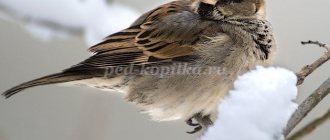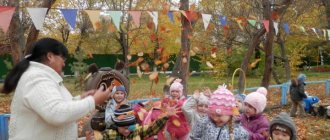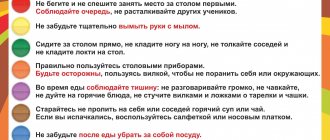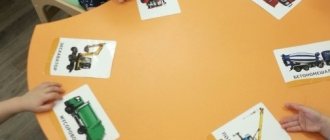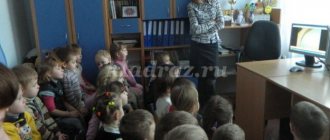Card index of walks in the first junior group
Elena Velgoretskaya
Card index of walks in the first junior group
Card index of walks . First junior group .
SEPTEMBER
Walk 1
Watching a butterfly helps children develop a caring attitude towards insects and develop the ability to see the beauty of the world around them.
Game exercise “Come to me”
- train children to run in a straight direction without stopping.
Didactic task “Big and small pebbles”
— teach children to distinguish objects by size.
Labor assignment “Let’s collect the toys at the end of the walk ”
- learn how to carry out simple tasks.
Individual work. Jumping forward.
Walk 2
Bird watching enriches children's understanding of the world around them.
Outdoor game "Bubble"
— to strengthen in children the ability to stand in a circle, gradually expand and narrow it.
Didactic game “Recognize by sound”
- develop auditory attention.
Labor assignment “Let’s collect sand in the sandbox”
- learn how to carry out simple tasks.
Individual work. Game exercise “Walk along the path”
- exercise children in walking in a limited area.
Walk 3
Watching a dog - involve children in observing pets, forming ideas about pets.
Outdoor game “Sun and Rain”
- learn to act on a signal.
Didactic game “Sort by color”
— learn to distinguish primary colors,
group objects (sandbox molds)
by color.
Work. Let's collect twigs on the site - involve them in carrying out simple tasks.
Individual work. Jumping on two legs.
Walk 4
Observing flowers in a flowerbed - to develop the ability to see the beautiful things around, to admire the beauty of flowers, to teach how to treat plants with care.
Outdoor game "Cat and Mice"
- learn to walk in a circle, holding hands, run in different directions with the end of the poetic text.
Didactic game “Pick a ribbon for the dolls”
— learn to distinguish ribbons by length: long and short.
Work. We are building a road of sand - teaching us to work side by side with each other.
Individual work. Throwing at a target.
Walk 5
Observing a car that brings food to a kindergarten - involve in observing transport, learning to name the parts of the car: cabin, wheels, steering wheel, etc.
Outdoor game "Train"
- practice walking one after another, teach how to start and end the movement at the teacher’s signal.
Didactic game “Big - small”
— teach how to choose a home for a bear and a mouse.
(Draw houses in advance with a stick on the ground or with crayons on the asphalt.)
Labor. “Let’s sweep away the sand from the sides of the sandbox”
– cultivate a desire to work together with the teacher.
Individual work. Practice walking in a straight line.
Walk 6
Observing the work of a janitor is to introduce adults to the work and support the desire to help.
Outdoor game “Catch up with me”
- teach to run in a certain direction.
Didactic game “Recognize a friend by description”
- learn to recognize your comrades by the description of the teacher.
Work. We collect leaves - help the janitor.
Individual work. Jumping forward.
Walk 7
Observing the wind - introduce children to accessible natural phenomena, diversify play activities with the help of actions with pinwheels.
Outdoor game “Hit the target”
- develop eye and coordination of movements.
Didactic game “Bring the same object”
- teach to find similar ones among toys.
Work. Let's collect sand in the sandbox - involve them in carrying out work assignments.
Individual work. Repeat the Russian folk nursery rhyme “A fox with a box ran through the forest”
.
Walk 8
Bird watching - to cultivate an interest in the world around us, to maintain an interest in observing objects of wildlife, to cultivate a desire to take care of birds.
Outdoor game "Catch-up"
- practice running.
Didactic game “Recognize by sound”
- development of auditory attention.
Work. Collecting toys after a walk - cultivate a desire to put toys away after playing.
Individual work. Repeat the nursery rhyme “Big feet walked along the road...”
Walk 9
Observing clothes: your own and those of passers-by - activate your vocabulary on the topic “Clothing”
, to develop knowledge about how to dress in the fall.
Outdoor game “Run to me”
- practice running in one direction, without bumping into each other.
Didactic game “Find the cub”
— learn to find baby pets in
pictures .
Work. Let's collect the leaves - cultivate the desire to carry out assignments.
Individual work. Draw with a stick on the sand - develop interest in drawing/
Walk 10
Excursion to the kindergarten garden - to develop knowledge about vegetables, learn to name them.
Outdoor game “Catch the ball”
- teach to run in a certain direction.
Didactic game "Errands"
- learn to understand verbal instructions.
Work. Help in harvesting potatoes - cultivate a desire to help.
Individual work. Finger gymnastics “We chop and chop cabbage”
.
Walk 11
Observation of clouds: white, the wind drives the clouds, they change shape - attract to observations of natural phenomena.
Outdoor game “Shaggy Dog”
– learn to act on a signal, run in different directions without bumping into each other.
Didactic game “Wonderful bag”
- learn to identify objects by touch.
Work. Collect sticks on the site - involve children in completing assignments.
Individual work. Climbing on a gymnastic wall.
Walk 12
Observing seasonal and weather changes in nature - to form elementary ideas about autumn changes in nature.
Outdoor game "Cars"
— train children in running in different directions, in the ability to start moving and stop at a signal.
Didactic game “What color?”
- learn to distinguish passing cars by color.
Work. "Collecting twigs"
- accustom to work.
Individual work. Game exercise “Raise your legs higher”
- learn to step over objects 5-10 cm high.
Walk 13
Observation of transport - to form ideas about transport, about basic traffic rules.
Outdoor game "Cars"
— learn to move around the area without bumping into each other.
Didactic game “On our site”
- learn to navigate in space, name familiar objects.
Work. “Take the toys to the group ”
— teach
to clean up your toys yourself
a walk Individual work. "Catch and throw"
- practice catching and throwing a ball.
Walk 14
Tree observation: what kind of trees? what kind of leaves do they have? how do trees shake their branches? – involve in observing the trees on the site, develop speech.
Outdoor game “Sparrows and a car”
- learn to act on a signal.
Didactic game “Who and where?”
— learn to navigate in space, improve understanding of adult speech.
Work. Pour sand into the sandbox - teach how to carry out assignments.
Individual work. Speech game “Loud - Quiet”
.
Walk 15
Observation of grass: note what color the grass is, what it feels like, etc. - involve in observing objects of living nature.
Outdoor game “On a narrow path”
- develop a sense of balance.
Didactic game “Fox, dance!”
- learn to distinguish the sound of instruments by ear.
Work. We sweep the sides of the sandbox - to cultivate the desire to work together with adults.
Individual work. Running on a straight path.
October
Walk 1
Observing the grass on the site. Conversation on the questions: “What color is the grass? What does it feel like? Who eats weed? Can kids eat weed? - develop thinking, speech, teach to distinguish colors, explain that you can’t put inedible objects in your mouth.
Outdoor game “At the bear in the forest”
- teach children to run in all directions.
Didactic game “Guess what to do”
— teach children to correlate the nature of their actions with the sound of the tambourine. Developing children's ability to switch auditory attention.
Work. “We will help the janitor in cleaning the area”
- instill in children a desire to help adults.
Individual work. Throwing a ball at a distance.
Walk 2
Watching a cat is to expand your understanding of a pet – a cat. Cultivate a desire to care for animals.
Conversation on the topic: “Which animal lives at home with a person?”
- develop speech, consolidate knowledge about domestic animals.
Outdoor game “Dashing - catching up”
- learn to coordinate your actions with the actions of your comrades.
Didactic game “Sun or Rain?”
— teach children to perform actions according to the different sounds of the tambourine, develop in children the ability to switch auditory attention.
Work. Game exercise “Collect leaves”
- learn how to carry out work assignments.
Individual work. Exercise children in distinguishing between objects of contrasting sizes (a big house and a small house, a big ball and a small ball, etc.)
Walk 3
Observing transport - explain to children that cars drive on the roadway, the driver drives the car, and while driving in the car there is no need to distract the driver with conversations.
Outdoor game "Cars"
— teach children to run in different directions without bumping into each other.
Didactic game “Guess by sound”
- continue to isolate and recognize the sounds of individual musical instruments.
Work. Cleaning the kindergarten area - instilling a desire to help adults.
Individual work. Game exercise “Step over the stick”
- develop the ability to step over objects and not lose balance.
Walk 4
Watching the leaves fall - show children the variety of colors of golden autumn; reveal a new concept of “leaf fall”
.
Outdoor game “Who is quieter?”
— train children to walk on their toes in the indicated direction.
Didactic game “Collect red and yellow leaves”
- learn to distinguish between yellow and red colors.
Work. Collect toys at the end of the walk - accustom to work .
Individual work. Game exercise “Fetch the ball”
- develop the ability to maintain a certain direction while walking.
Walk 5
Bird watching. Cultivate a kind attitude towards birds.
Outdoor game “Shaggy Dog”
— teach children to listen to the text and quickly respond to the signal.
Didactic game “Where did they call?”
— teach children to determine the direction of sound.
Work. Collecting leaves in a pile - to cultivate a desire to help adults.
Individual work. Game exercise “Catch the ball”
.
Walk 6
Observation of a birch tree. Examine the birch tree: the leaves have turned yellow, the breeze is blowing, the birch tree is swaying, dropping leaves.
Breathing exercise “Breeze”
.
Outdoor game “Catch the ball”
- develop the ability to maintain the required direction while walking and running.
Didactic game “Loud-quiet”
— teach children to change the strength of their voice: speak quietly, then loudly.
Work. "Let's collect sand in the sandbox"
- involve children in carrying out assignments.
Individual work. Running between two lines - develop coordination of movements.
Walk 7
Observation of the sky, conversation on the questions: “Show me where the sky is? What's in the sky? Who's flying in the sky?
- develop speech, cultivate interest in the environment.
Outdoor game “Sun and Rain”
— learn to navigate in space, act on a signal.
Didactic game “Guess by Voice”
— teach children to distinguish between animals and birds by their voices, to form verbs from onomatopoeic words
(crows, meows, chirps, etc.)
Labor. Collect branches on the site - involve in carrying out work assignments together with children of the older group .
Individual work. Game exercise “Step over the stick”
— develop the ability to step over a stick without losing balance.
Walk 8
Observing flowers in a flower bed. Draw children's attention to the wilting of flowers. Form ideas about autumn changes in nature.
Outdoor game “Shaggy Dog”
— teach children to listen to the text and quickly respond to the signal.
Didactic game “One - many”
- learn to distinguish the number of objects.
Work. Offer to help the janitor collect leaves from the area. Cultivate a desire to help adults.
Individual work. Practice climbing a gymnastic ladder.
Walk 9
Observation of the wind - the wind blows, tears leaves from the trees. Introduces children to accessible natural phenomena and fosters interest in the world around them.
Breathing exercise “Breeze”
.
Outdoor game “Cat and Birds”
- develop speed and agility.
Didactic game “Name the baby pet”
- develop speech, consolidate knowledge about domestic animals.
Work. Collect leaves in a certain place - involve in carrying out simple tasks.
Individual work. Game exercise “Catch the ball”
- teach to run in a certain direction.
Exercise children in onomatopoeia - exercise “Who says what”
.
Walk 10
Observing the sky (gray, drizzling, no sun, birds hidden)
- cultivate interest in the world around us.
Outdoor game “Through the Stream”
- learn to step over obstacles.
Didactic game “Guess by Voice”
— teach children to distinguish between animals and birds by their voices, to form verbs from onomatopoeic words
(crows, meows, chirps, crows, etc.)
Labor. “Collect pebbles from the area”
- involve children in carrying out simple tasks.
Individual work. Repeat the poem by A. Barto “Horse”
.
Walk 11
Observing an earthworm, considering how it moves, telling where it lives - to cultivate interest in the environment.
Outdoor game “Giant Dwarfs”
- learn to act on a signal, walk without bumping into each other.
Didactic game “Big and small leaves”
— teach children to distinguish objects by size.
Work. Helping the janitor clean the area encourages the desire to help adults.
Individual work. Remember the poem "Ball"
A. Barto.
Walk 12
Observation of trees: examine the trees, its main parts, offer to stroke the trunk - introduce objects of living nature.
Outdoor game “Birds in the nest”
- learn to walk and run in all directions.
Didactic game “Recognize by sound”
- develop auditory attention.
Work “Collecting leaves in a bucket”
- learn how to carry out simple tasks.
Individual work. Practice climbing a gymnastic wall.
Walk 13
Observing the work of a janitor, providing all possible assistance - to cultivate an interest in the work of adults and a desire to help.
Outdoor game “Shaggy Dog”
- develop the ability to run in different directions without bumping into each other.
Didactic game “Find a place for the dog”
- learn to navigate in space.
Work. Helping the janitor clean the area – maintaining the desire to help.
Individual work. Finger game "Magpie-Magpie"
, game exercise
“Catch the ball”
.
Walk 14
Observing street life: observing moving vehicles - learning to distinguish vehicles: car, bus, tractor, truck, etc.
Outdoor game “Sparrows and a car”
— introduce children to basic traffic rules, practice running in different directions, teach them to run without bumping into each other.
Didactic game “Big - small”
- develop attention, thinking, learn to classify objects by size.
Work. Sweep in the gazebo - get used to work.
Individual work. Repeat the nursery rhyme “Bai-bai - you, little dog, don’t bark”
. Train children in jumping while moving forward from a standing position.
Walk 15
Observing children's clothes and shoes - enriching vocabulary (overalls, jacket, boots, shoes, etc.)
.
Outdoor game "Legs"
- create a good mood, continue to teach to listen to adults.
Didactic game “Wonderful bag”
- contribute to the development of the ability to examine objects.
Work. “Let’s gather the twigs in a pile”
- cultivate a desire to work.
Individual work. Game exercise “Step over the stick”
- practice stepping over obstacles.
November
Walk 1
Observation of a tree. Introduce children to the signs of autumn (trees shed their leaves, develop a caring attitude towards nature (tree branches should not be broken)
.
Outdoor game “Catch me”
— learn to run in a certain direction without bumping into each other.
Didactic game “Tall and low trees”
- learn to distinguish trees by height.
Work. Let's collect pebbles on the site - teach them to carry out the simplest instructions.
Individual work. Remember the nursery rhyme “Our ducks in the morning”
. Practice climbing a gymnastic wall.
Walk 2
Observing the weather of the day - forming ideas about autumn changes in nature.
Outdoor game "Bubble"
- develop the desire to play outdoor games with the teacher.
Didactic game “One - many”
- learn to distinguish the number of objects.
Work. We collect leaves in a bucket - to cultivate the desire to work together with adults.
Individual work. Finger gymnastics “Finger-boy, where have you been?”
Walk 3
Observing the wind - pay attention to the branches of the trees, to the leaves, how they are quietly swayed by the wind. Invite children to pretend to be a breeze - breathing exercise “Breeze”
.
Outdoor game "Cat and mouse"
- develop motor activity, learn to act on a signal, run without bumping into each other.
Didactic game “Guess by description”
- learn to guess from the description which of the children the teacher guessed.
Work. Sweep in the gazebo - teach how to carry out simple tasks.
Individual work. Exercise children in catching a ball.
Walk 4
Observing the work of adults - to cultivate interest in the work of adults.
Outdoor game "Who is quieter"
- exercise children in walking on their toes.
Didactic game “One-many”
- learn to distinguish the number of objects.
Work. Providing all possible assistance in clearing the area of leaves - fostering a desire to help.
Individual work. Throwing a ball long distance with the right and left hand.
Walk 5
Observation of the roadway - to give an idea of the rules of the road.
Outdoor game “Where is it ringing?”
- learn to navigate in space.
Didactic game “Curious doll”
- teach children to answer the questions
“who?”
,
"What?"
,
"what is he doing?"
Work. We collect the twigs in one place - teach them to carry out simple tasks.
Individual work. Train children to jump in place.
Walk 6
Bird watching - talk about the fact that as cold weather approaches, birds have less food, and people should take care of them. Cultivate a caring attitude towards birds.
Outdoor game "Legs"
- practice alternating movements
(running, walking, jumping, squats)
.
Didactic game “Guess by sound”
- continue to isolate and recognize the sounds of individual musical instruments.
Work. Sweep in the gazebo - involve in carrying out work assignments.
Individual work. Jumping on two legs while moving forward.
Walk 7
Observing the rain - to consolidate ideas about autumn changes in nature: it rains often, it is damp and cloudy outside.
Outdoor game "Cats and Mouse"
- practice running when given a signal.
Didactic game “Name the color”
- learn to distinguish primary colors.
Work. Collecting toys at the end of a walk - fostering a desire to carry out work assignments.
Individual work. Climbing a gymnastic wall.
Walk 8
Observation of trees - draw children's attention to branches without leaves, tell them that trees shed their leaves in the winter - introduce them to objects of wildlife, cultivate a caring attitude towards trees.
Outdoor game “Catch up with me”
— exercise children in running and walking in a certain direction.
Summary of the walk for the first junior group “Such different autumn leaves”
Target:
- show that autumn is a wonderful time of year;
- develop a caring attitude towards trees;
- develop coherent speech, the ability to speak clearly, understandably, listen carefully and share knowledge and impressions with peers.
Progress of the walk.
I go out with the children to the area where the Hare (an adult dressed in an appropriate costume) is waiting for us.
Hare: Hello, guys! Look how beautiful it is around. How the trees dressed up! What are the leaves on the trees like? Children answer: yellow, brown, red!
Educator: Multi-colored park!
Multicolored garden.
Leaf fall has begun
The leaves have begun to fall.
Under the guys' feet,
The leaves are spinning merrily!
What is leaf fall? (Children answer; if they find it difficult to answer, I help them answer correctly). Leaf fall is when leaves fall from trees. At what time of year do the leaves fall from the trees?
Children: Autumn!
Educator: Let's walk through the autumn leaves together with the bunny. What are the leaves doing under your feet?
Children: Rustling!
Educator: Correct! Together with Bunny, let’s say “rustling” (everyone repeats the word rustling together). Bunny, what are you holding in your paws?
Hare: In my paws I have a beautiful, multi-colored bouquet of leaves. Here is a leaf for Tanya, and this birch leaf is for Ruslan. (Gives each child a piece of paper)
Educator: Bunny, our children want to know why the leaves fall from the trees in the fall?
Hare: Do you see how many leaves are on the ground? All the trees that we have on our site: birch, poplar, rowan, apple tree - this is how they prepare for the winter cold. The leaves will cover the ground with a continuous carpet and protect the roots of the trees from frost. The ground under the fallen leaves will not freeze deeply, and the snow will not thicken much in winter. In the spring, when the snow melts, the ground under the fallen leaves will retain moisture longer.
Educator: Zainka, look, the children and I will help the tree survive the winter.
Hare: What will you do? (Children answer).
Educator: That's right, let's put the leaves we played with around the trunk of our beautiful birch tree. Why do we cover a birch tree with leaves? (Children answer). You are absolutely right, so that it does not freeze, and in winter we will sizzle the leaves with snow, and when spring comes, the snow will melt and our birch tree will bloom its beautiful leaves. Children, look, while we were caring for our birch tree, the bunny became sad. Bunny, what happened? Why are you so sad?
Hare: I’m sorry that I won’t see leaves on the trees until spring.
Educator: How can we help, Bunny? (Children answer) Don’t be upset, bunny, the guys and I will now collect a lot of different leaves, bring them to the group, dry them, make a herbarium out of them and admire the leaves.
The game is played: One, two, three - bring a beautiful leaf from a birch (rowan, apple) tree!
Hare: I'm playing swami, and it's time for me to run home. But I’m not upset, because we will definitely see each other again. Goodbye! (Runs away, children wave).
Free activity of children under the supervision of a teacher.


